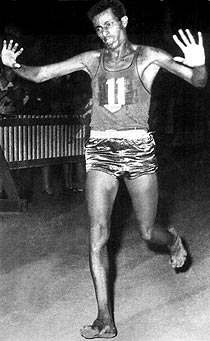Shoes and Pronation
For a physics lesson on shoes, read "Running Shoes"
10,000 World record holder Haile Gebrselassie ETH(Left)
defeats Paul Tergat KEN(right) for Gold 2000 Olympics
Notice:Flexed knee(left) - extended knee(right: foot-descent)

Photo courtesy of http://www.madeinethiopia.net/ethiopiasport/10_000M/10_000m.html
It is visible from the picture above, that the knee extends during the foot descent period. There is an astounding contact force that occurs when the foot strikes the ground. Upon impact, the weight of the runner is initially on the outside of the foot(above). To achieve better stability pronation occurs.
What is Pronation? This occurs when the foot strikes the ground and the arch flattens out. The foot will pronate to absorb the shock when the heel hits the ground, and to offer better balance through the mid-support phase. The ankle will "tip" to the inside.The runner rolls his foot so the weight is placed on the inside and take-off is possible.
Over pronating? Flat footed people will tend to over pronate, becuase their arch is already flat. This makes it uncomfortable to run, becuase less shock is being abosrbed. Proper footwear and orthotics are available to correct this problem.
Good Arches:
Abebe Bikila of Ethiopia(below) won the 1960 Olympic
marathon barefoot.
Abebe Bikila. Gold medal 1960 Olympics
(click on picture to read article)

Picture courtesy of
http://ex.matrix.msu.edu/africa/teachers/current/menstrack.htm
Cushions for Shoes: Help absorb the shock when a runner's foot strikes the ground. Cushioning decreases the amount of force felt by the runner's feet and joints.